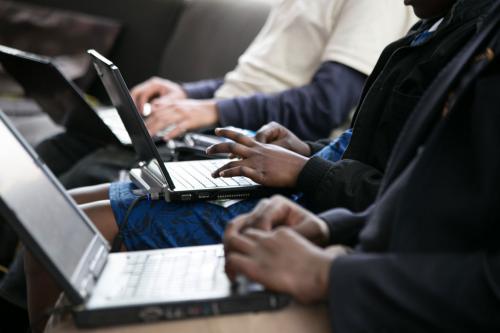Near-worldwide improvement in ICT development; but disparity among countries persists – UN
Global information and communication technologies data released by the United Nations agency responsible for ICT shows that the world is more connected than ever, but also reveals that many are still not using the Internet, and most do not fully benefit from its potential on Nov 22.

People using the Internet in Nairobi, Kenya.
“To bring more people online, it is important to focus on reducing overall socio-economic inequalities [particularly] education and income levels” the UN International Telecommunication Union (ITU) Secretary-General, Houlin Zhao, said releasing the statistics on Nov 22.
World improves, but countries lag behind
According to the latest edition of the ITU Measuring the Information Society Report average global IDI saw an improvement from 4.74 in 2015 to 4.94 in 2016 with Republic of Korea led the ICT Development Index (IDI) for the second year running with two other Asian economies – Hong Kong, China; and Japan – featured in the top 10, the seven others were in Europe.
“During the [2015-2016] period, stronger improvements have been made on ICT use than access, mainly as a result of strong growth in mobile-broadband uptake globally. This has allowed an increasing number of people, in particular from the developing world, to join the information society and benefit from the many services and applications provided through the Internet,” explained Brahima Sanou, Director of ITU Telecommunication Development Bureau, responsible for the report.
However, while the world as a whole improved, significant differences in the levels of ICT development between countries and regions persisted.
Chart-topping Republic of Korea’s IDI read 8.84 this year but Sub-Saharan Africa’s Niger, with an IDI of 1.07, ranked lowest among the 175 economies covered by the ITU index.
For regions, Europe led the way in ICT development and a number of countries in the Americas also made significant progress, as did those in the Commonwealth of Independent States (CIS) region.
Similarly, while a number of Asian and Pacific countries made significant advances, nine out of its 34 countries, including several with large populations, remained least connected. The diversity also persisted in the Arab region.
The worst performing region was Africa where average IDI for 2016 was 2.48 points, just over half the global average (4.94), reflecting the lower level of economic development, which inhibits ICT development.
Internet potential underutilized
The report also revealed that mere access to the Internet is not sufficient, and underlined the need to address broader socio-economic inequalities to help people acquire the necessary skills to take full advantage of the Internet and use its advanced services, such as e-commerce.
“This is in line with a more integrated development approach, like that adopted in the 2030 Agenda, which highlights that development challenges are [inter-]linked and cannot be achieved in isolation,” said ITU.
Nearly as many mobile-cellular subscriptions as people on Earth!
At the end of 2016, there will be almost as many mobile-cellular subscriptions as there people and 95 per cent of the global population will live in an area that is covered by a mobile-cellular signal.
ITU, however, cautioned that since many people have multiple subscriptions or devices, other metrics need to be produced to accurately assess mobile uptake, such as the number of mobile phone users or mobile phone owners.
Declining prices of mobile connectivity
Another positive development helping expand connectivity was falling mobile-cellular prices in least developed countries (LDCs), which saw a 20 per cent decrease in these cellular prices, the strongest decline in five years.
For the first time, the average monthly cost of “mobile-cellular basket” – 100 SMS (text messages) and 30 mobile calls – in developing countries accounted for less than five per cent of the gross national income (GNI) per capita.
Fixed-broadband still costly
While prices for fixed-broadband continued to drop significantly in 2015, but remained high and clearly unaffordable in a number of LDCs.
Globally, the price of a basic fixed-broadband connection fell from around $80 per month in 2008, to $25 in 2015. However when compared to gross national incomes, in LDCs, a fixed-broadband plan with a minimum of one gigabyte of data per month still corresponds to over 60 per cent of GNI per capita.
Source:United Nations
- 310 reads
Human Rights
Fostering a More Humane World: The 28th Eurasian Economic Summi

Conscience, Hope, and Action: Keys to Global Peace and Sustainability

Ringing FOWPAL’s Peace Bell for the World:Nobel Peace Prize Laureates’ Visions and Actions

Protecting the World’s Cultural Diversity for a Sustainable Future

Puppet Show I International Friendship Day 2020

